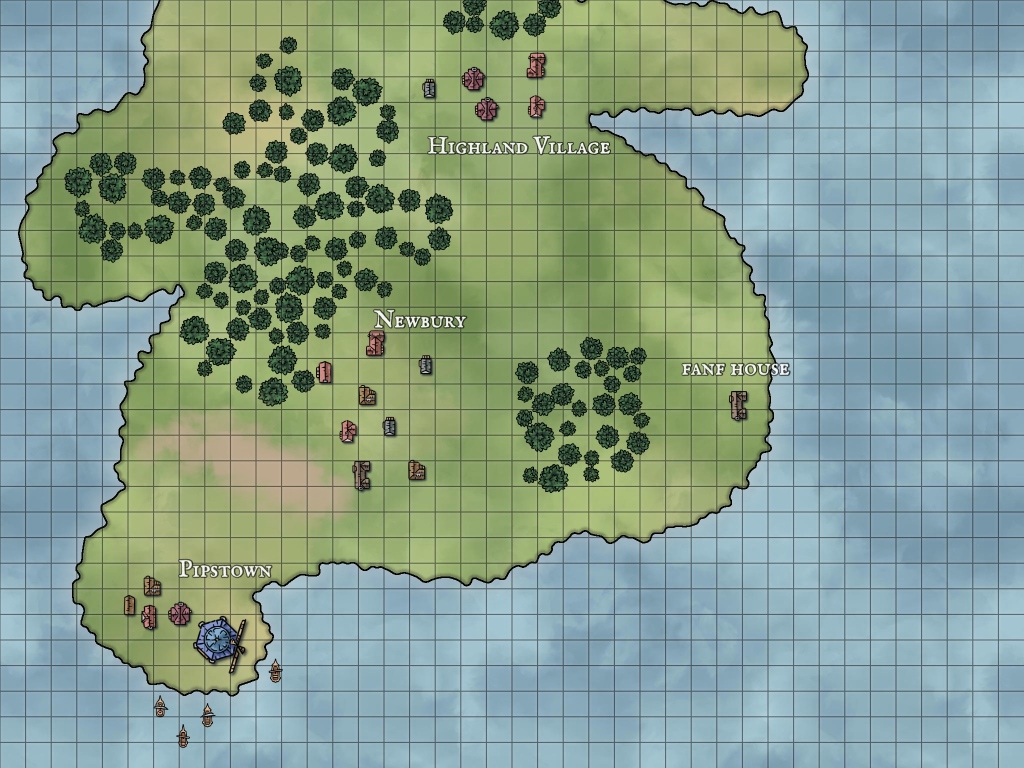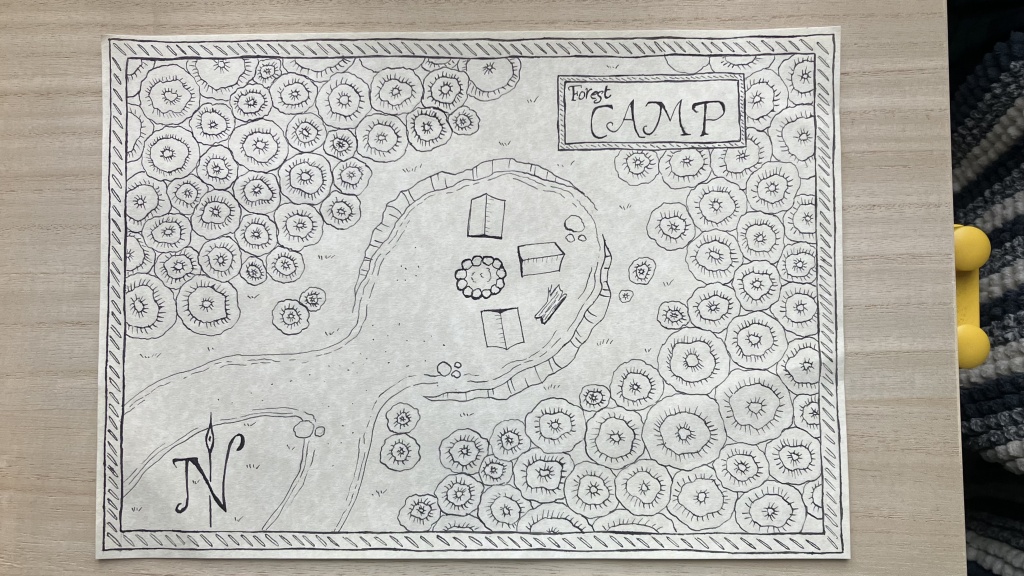Practice 1 has invited me to start understanding why I create the things that I do. Although I believe that this is a deeper subject that will not be decided completely yet, I have started reflecting at first on what other practitioners do differently to me. In practice 1, I am looking at mapping technologies in response to a world issue, as a commissioning cartographer it seems like an important time to take note of where the field is headed and take some critical analysis to ensure I do not remain stagnant in the field.
My primary application of cartography is within the world of Dungeons & Dragons, a tabletop role-playing fantasy game where players create characters and embark on adventures led by a game master, rolling dice to determine whether choices can come to fruition. Within the game itself, in the recent Covid years, the potential for map making has jumped quickly into the digital age. What was once a game played sat around a table in person became an online discord led game overnight. The mapping technology suddenly became a necessity and companies were able to fulfil this need quickly with software’s that were already running but upgraded to entice players that never would have turned to digital unless necessary. The maps on these programs are dynamic, animated and immersive in a way that paper maps cannot offer. Roll 20 is one software that exploded due to its free access and user friendly features. It offers live tracking on the maps between players as well as a server for voice and video chat and doubled its users from 5 million to 10 million in just the lockdown years. (Meehan, 2022) The map software itself offers dynamic lighting meaning that dungeon rooms can be discovered when walking near to them or unlocking a door, rather than seeing it immediately playable. These digital software’s have almost become a GIS system for the game, whereby the maps contain information about an abundance of in game references and not just the map interface. Character data, map and land data, battle data and weather data are all collected here and even though are based in fantasy and storytelling, do in fact constitute a GIS system. Foundry is a similar software that boasts even bigger databases and upgraded its features but for a cost.

From personal experience these maps were exciting. I had a great time exploring the maps within my browser without even having to wait my turn. With programs such as Inkarnate in the market, which allows users to create maps with pre-made templates, it was suddenly easier than ever for original maps to be made by anyone at any time. This reduced the need for artist made maps whether hand drawn or digital. The joy of Dungeons & Dragons is playing stories that are designed by individuals and not always by the creators of the game, with map making software’s easily accessible, this has become easier than ever and plug that map into a software such as Roll20, suddenly you have dynamic and interactive original maps in minutes.

These findings are a hard pill to swallow for a traditional cartographer. Although I still receive work for traditional maps and sometimes even digitally drawn maps, it would seem that I am missing a need for the market. To keep up with the way that people are playing the game currently means I must keep in touch with the software. My own practice must look towards the innovation even if I also keep roots in the traditional. By looking into the importance of cartography within games specifically I can begin to tailor my practice and perhaps even start to understand why I create them in the first place. Wizards of the Coast has recently unveiled plans for a digital play area using unreal engine. (Anderson, 2022) Although this will most likely be inaccessible due to cost to most players it shows a clear pathway towards digital play and potentially hints at the possibility for the platform to head into virtual reality. It is therefore important that I take this into consideration for my practice and not only propel my options to cover the now, but also the future possibilities. By thinking this way, I could sit in a pioneers seat.
“One of the most interesting developments over the past decade or so has been the growth of small cartographic service providers all over the world, dedicated to meet the often traditional needs of map clients.” (Wood, 2001) This paper talks about where the future of cartography may be heading versus where it stands traditionally. It explains that cartographers have been given a death sentence in favour of digital routes and systems however, it also discusses a niche need for paper maps and the weaknesses of the web lying in distraction. Another paper makes a good point however; “The application of computer technology in cartography is especially important because the process of map production is rather complex and very long, and therefore many maps are out of date in the moment of publishing.” (Franges, 2013) Franges points out a particular problem with the contemporary world in that we simply cannot work quickly enough before an environment changes. Both papers here are talking about real world mapmaking rather than fantasy mapmaking to which I have been referring to however, it is important to understand issues relating to all kinds of cartography. The same arguments here can be applied to fantasy cartography particularly Franges. A fantasy world can be built, destroyed and rebuilt as often as a game might require meaning that a map can become redundant simply by a player’s decision in-game.
With some of my research material talking about general world mapping it may be important to understand a small history of maps to determine why they are even needed in the first place. It is only then we can uncover why they are needed in games. To map an area is a basic human instinct and we have been doing it for centuries. As new lands are discovered by each culture a map is created to record that knowledge, often showing the homeland at the centre and the new lands around this. Many maps were created by monks and kept by the church in their vast libraries of scrolls and knowledge and it is here that we can begin to see maps being illustrated with more than just paths and rivers. The image below shows a figure, assumed to be Christ, encompassing the map in an embrace. The embrace suggests that the map is showing Christian known lands and therefore their deity is taking care of those lands. It also serves as a compass in some ways with the head oriented East, meaning that East is up, presumably because of the sunrise. (Nurminen, 2015) Cartography through history has always aimed to map the world around us and I expect always will even though it is no longer monks creating them by hand. It is easy to see then why game mechanics need to use maps as a necessity. Video games map their world so that a player can firstly understand where they need to go within the game but secondly to immerse themselves within the world itself. Maps are a fantastic way to fulfil that immersion quickly. Games such as the Legend of Zelda: Breath of the Wild for example also let you uncover the map as you reach certain regions in a Columbus style discovery of the wider world. It even has a feature that shows a GPS style walkway of where you have been on that map during the entire gameplay. Video games tend to highlight concepts that extend beyond everyday life. This often results in maps and mapping technologies that are more robust and interactive than those for real-world use: locations (e.g., those visible, but not reachable; locked doors) and objects (e.g., plants; stones; puzzles) all have the potential to be essential to the everyday life of a video game resident. (Toups, 2019) Video games answer to our human need for knowledge, but within their fantasy worlds to enable us to immerse ourselves in the story better. The same can be said of why many books include maps, for narrative and immersion purposes. Dungeons & Dragons follows this same idea of world mapping and discovery but with changeable maps and often on paper. Dungeon or map tiles are commonly used to change terrain quickly and change the map as the narrative evolves live. Now taken to a digital platform the results are still the same, mapping is necessary for the engagement of the player and understanding of the story. In reality and reflection, maps are never going away and so why is cartography known as a dying skill? It seems that It is simply a case of how the cartography is evolving with technology determines how useful a cartographer is, and how we differ from the D.I.Y mapmakers of today.

The overarching objective of this post is to discover how I can implement growing trends within my practice and see potential in a future where I can start a journey into the ‘why’. After researching the current programs used and understanding some cartographic history and importance I can move onto direct observation. Here I have created a basic traditional map in my style as I would for a commission. Using Adobe after effects I have added a layer of dynamic effects to simulate leaves rustling in the wind and the glowing embers of a fire as well as small movement in the trees. The effects are rudimentary, but I learned a tremendous amount. The main learning curve that I have taken away from the experience is that I must think about how my illustrations can be used with effects later. If I wish to continue using digital tools over the top of my traditional drawings, then I must think of animations or effects in the initial stage of drawing. The movement in my trees is affected by the fact that the banner is placed within them. This would be better placed as a separate layer and therefore drawn separately, perhaps even the same with the border. Not only has this been an epiphany into bringing my practice into a digital format but has given me some fantastic reflections on how I can go forward with my work. By adding very simple layers of digital effects I can stay current within the field whilst still offering the nostalgia of hand drawn. In a sense this has developed a new style for me.



Above: video showing effects added to the map using After Effects.
Bibliography
Anderson, J. (2022) Wizards presents unveils the future of 5E with one D&D, including digital maps. [Online] Available at <https://www.cbr.com/wizards-presents-dnd-digital-play-area-updated-5e-sourcebooks-dnd-beyond/> [Accessed 27/10/2022]
Blando, J. (2015) How to draw fantasy art & RPG maps. Impact books: Penguin Random House.
Blando, J. (2019) Fantasy Mapmaker. Impact books: Penguin Random House.
Franges, S, Et Al. (2013) ‘The future of cartography’. Kartografija I Geoinfomancije. 1(1). PP6-21. [Online] Available at < https://doaj.org/article/fb93ab96e3174ea5b9acb59cc41e7246 > [Accessed 27/10/2022]
Meehan, A. (2022). Roll20’s userbase has doubled since 2020. [Online] Available at <https://www.dicebreaker.com/companies/roll20/news/roll20-userbase-doubles> [Accessed 27/10/2022]
Nurminen, M. (2015) ‘The mapmakers world’. Oxford: The pool of London Press
Toups, Z.O. (2019) ‘Making maps available for play: analysing the design of game cartography interfaces’. ACM transactions on computer-human interaction. 25(5). PP1-43. [Online] Available at < https://dl.acm.org/doi/abs/10.1145/3336144 > [Accessed 27/10/2022]
Wood, M. (2001). ‘The 21st century- No future without cartography’. Journal of Geospatial Engineering. 3(2) PP77-86 [Online] Available at < <http://www.lsgi.polyu.edu.hk/sTAFF/zl.li/vol_3_2/01_wood.pdf > [Accessed 27/10/2022]
Leave a comment